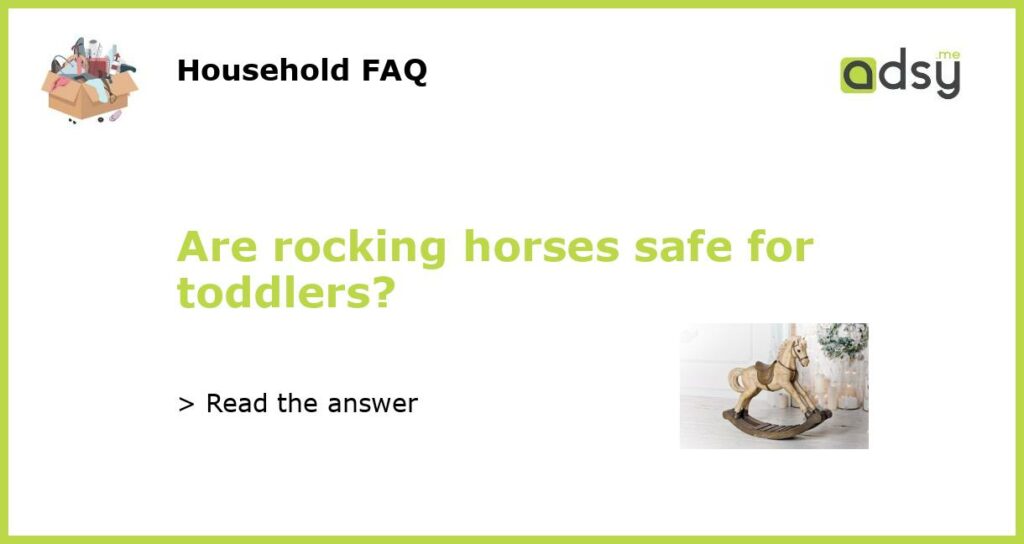Are Rocking Horses Safe for Toddlers?
Introduction
Rocking horses have been a classic toy for generations, providing hours of entertainment and imaginative play for children. However, when it comes to safety, concerns arise. Many parents wonder if rocking horses are safe for toddlers. In this article, we will explore the potential risks associated with rocking horses and provide tips on how to ensure your toddler’s safety while enjoying this timeless toy.
Potential risks of rocking horses
While rocking horses can be a delightful addition to any toddler’s playroom, they do come with potential risks. One of the main concerns is the risk of falling. Toddlers can easily lose their balance, especially if they are not yet proficient in sitting independently. Another risk is pinching or trapping fingers or toes in the rocking mechanism of the toy. In addition, rocking horses with small parts or loose screws can pose a choking hazard to curious toddlers.
Ensuring safety while using rocking horses
Although there are risks associated with rocking horses, they can still be a safe and enjoyable toy for toddlers with proper precautions. Here are some tips to help ensure your child’s safety while using a rocking horse:
a) Choose a stable and sturdy rocking horse: When purchasing a rocking horse, opt for one with a wide and stable base. This will minimize the risk of the toy tipping over while your toddler is playing. The horse should also be made of high-quality materials and securely built to prevent any potential accidents.
b) Supervise your toddler: It is essential to supervise your toddler while they are using a rocking horse, especially if they are still developing their balance and coordination skills. This way, you can quickly intervene if they start to lose their balance or if any potential hazards arise.
c) Ensure proper fitting and safety features: Make sure your toddler is securely positioned on the rocking horse. If the horse has stirrups, ensure they are adjusted appropriately for your child’s comfort and safety. Additionally, look for rocking horses with safety belts or straps to further secure your toddler while they play.
d) Regularly inspect the rocking horse: As with any toy, it is crucial to regularly inspect the rocking horse for any wear and tear. Check for loose screws, broken parts, or any potential choking hazards. Ensure that all components are well-maintained and in good working condition before allowing your toddler to play with the rocking horse.
Alternatives to rocking horses
If you have concerns about the safety of rocking horses for your toddler, there are alternative options that provide similar benefits without the potential risks. Consider the following alternatives:
a) Rocking chairs: A child-sized rocking chair can provide a similar rocking motion without the height or risk of falling associated with rocking horses. It also allows for a more versatile seating option for your toddler.
b) Ride-on toys: Ride-on toys, such as scooters or tricycles, provide a fun and active play experience for toddlers. These toys often have safety features, such as handlebars or seat belts, to ensure the child’s stability and minimize the risk of accidents.
c) Balance bikes: Balance bikes are a great alternative for toddlers who enjoy the motion of rocking horses but require more stability. These bikes teach balance and coordination skills, preparing your child for eventually riding a traditional bicycle.
Conclusion
Rocking horses can be a safe and enjoyable toy for toddlers when proper precautions are taken. By choosing a stable and sturdy rocking horse, supervising your child while they play, ensuring proper fitting and safety features, and regularly inspecting the toy, you can minimize the potential risks associated with rocking horses. However, if you have concerns about safety or prefer alternative options, consider rocking chairs, ride-on toys, or balance bikes as suitable alternatives for your toddler’s playtime. Remember, the key is to prioritize your child’s safety while still providing them with opportunities for fun and imaginative play.






